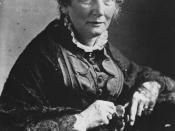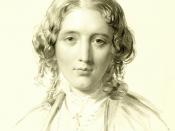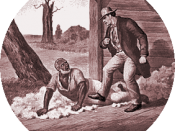Legend claims that Abraham Lincoln greeted her as "the little lady who made this big war." This lady who appealed for an end to slavery in the United States used a vision she had during a church service of a black man being beaten. This vision became the inspiration and main idea for her novel "Uncle Tom's Cabin", or "Life Among the Lowly". Harriet Beecher Stowe, a realist used her book to convey the evils of slavery by using symbolism and characterization.
The developments throughout the novel by the use of symbolism are seen in two ways: objects and metaphors. Stowe uses two primary objects: the cabin and the North side. Tom's cabin represents freedom. After Tom's death George Shelby motivates his slaves to see the cabin as a reminder of the importance of being as honest and faithful a Christian as Uncle Tom, who was clearly a good example of one.
The cabin also represents "the destructive power that had slavery" (Stowe 474). It also stands for the Christian love of Tom when he showed that unbelievable love toward people who had made his life miserable as a slave. It also demonstrates how he treated his hideous master with that love which only could come from a higher being which is God.
The other important object Stowe uses is the North side, seen as an actual item of freedom from slavery. This side has a view of slavery very different from that of the South. The North believes slavery is wrong, and they are against it, while the South supports it. The other method that Stowe uses to convey the evil of slavery is through metaphors. One important metaphor in the novel is Eliza's leap, which represents leaving slavery and entering freedom. This...


